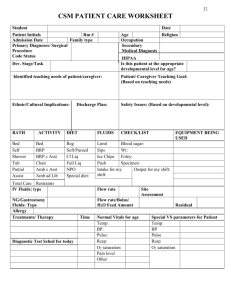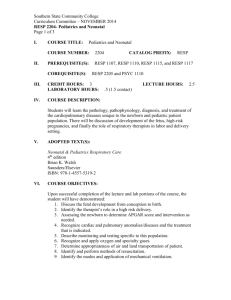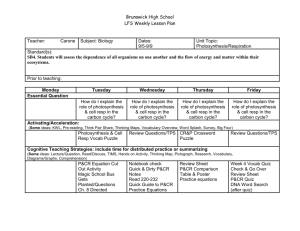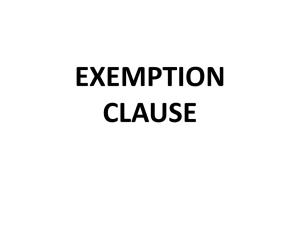:f: SUBRINGS I-RINGS AND S-RINGS Drpartement
advertisement
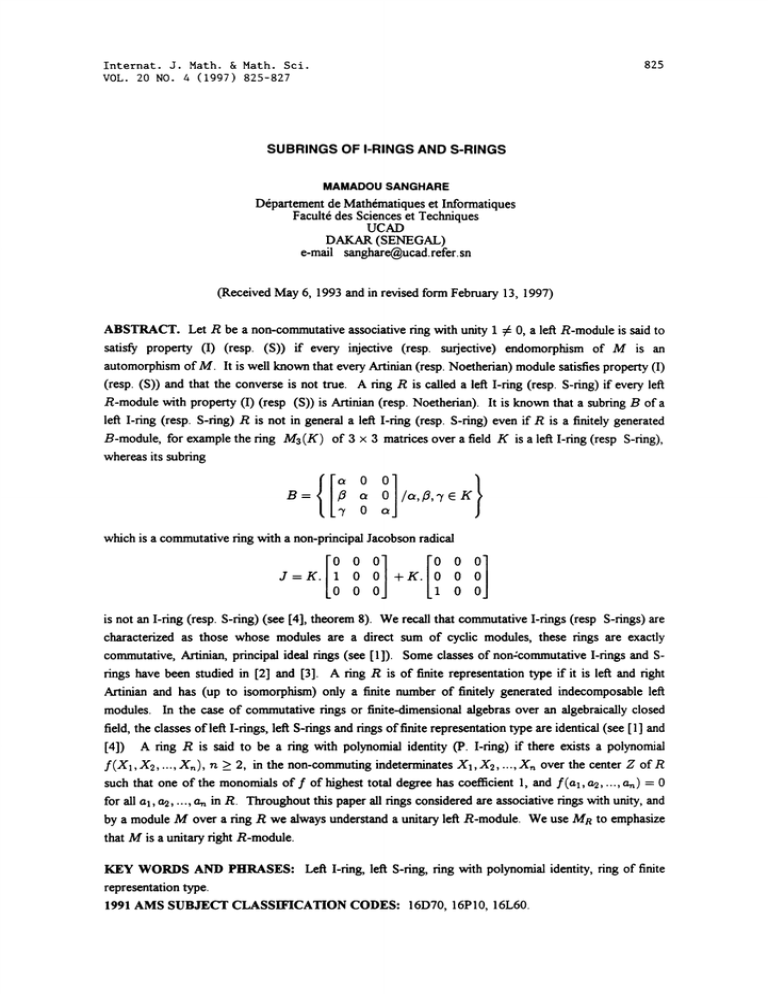
Internat. J. Math. & Math. Sci.
VOL. 20 NO. 4 (1997) 825-827
825
SUBRINGS OF I-RINGS AND S-RINGS
MAMADOU SANGHARE
Drpartement de Mathrmatiques et Informatiques
Facult6 des Sciences et Techniques
UCAD
DAKAR (SENEGAL)
e-mail sanghare@ucad, refer, sn
(Received May 6, 1993 and in revised form February 13, 1997)
ABSTRACT. Let R be a non-commutative associative ring with unity 1 :f: 0, a left R-module is said to
satisfy property (I) (resp. (S)) if every injective (resp. surjective) endomorphism of M is an
automorphism of M. It is well known that every Artinian (resp. Noetherian) module satisfies property (I)
(resp. (S)) and that the converse is not true. A ring R is called a left I-ring (resp. S-ring) if every left
R-module with property (I) (resp (S)) is Artinian (resp. Noetherian). It is known that a subring B of a
left I-ring (resp. S-ring) R is not in general a left I-ring (resp. S-ring) even if R is a finitely generated
B-module, for example the ring M3 (K) of 3 x 3 matrices over a field K is a left I-ring (resp S-ring),
whereas its subring
B=
a
7
0
0
which is a commutative ring with a non-principal Jacobson radical
J=K. 1 0
+K. 0 0 0
00
100
is not an I-ring (resp. S-ring) (see [4], theorem 8). We recall that commutative I-rings (resp S-tings) are
characterized as those whose modules are a direct sum of cyclic modules, these tings are exactly
commutative, Artinian, principal ideal rings (see [1]). Some classes of non-’commutative I-tings and Stings have been studied in [2] and [3]. A ring R is of finite representation type if it is left and fight
Artinian and has (up to isomorphism) only a finite number of finitely generated indecomposable left
modules. In the case of commutative tings or finite-dimensional algebras over an algebraically closed
field, the classes of left I-tings, left S-tings and tings of finite representation type are identical (see [1] and
[4]) A ring R is said to be a ring with polynomial identity (P. I-ring) if there exists a polynomial
f(X1,X2,...,X,), r > 2, in the non-commuting indeterminates X1,X2,...,X, over the center ,7 of R
such that one of the monomials of f of highest total degree has coefficient 1, and f(al, a2, a) 0
for all al, a2, a in R. Throughout this paper all rings considered are associative rings with unity, and
by a module M over a ring R we always understand a unitary left R-module. We use MR to emphasize
that M is a unitary fight R-module.
KEY WORDS AND PHRASES: Left I-ring, left S-ring, ring with polynomial idemity, ring of finite
representation type.
1991 AMS SUBJECT CLASSIFICATION CODES: 16D70, 16P10, 16L60.
M. SANOHARE
826
THE MAIN RESULT
THEOREM. Let R be a left I-ring (resp. S-ring), and B be a sub-ring of R contained in the center
Z of R Suppose that R is a finitely generated fiat B-module Then B is an I-ring (resp S-ring)
To prove this theorem we need some results.
It is easy to see that
LEMMA 1. Every homomorphic image of a left I-ring (resp S-ring) is a left I-ring (resp S-ring)
LEMMA 2. Let Px and P2 be two prime ideals of a ring R. If P1 is not contained in P2 then
1.
Hom(R/P, R/P2)
{0}
PROOF. Let f- R/P1 R/P2 be an R-homomorphism, and set f (1 + P1
+ P2, where
x
r
Let
We
and
let
R.
R.
be
xrt
element
in
have
any
E
E
+ P_ Thus
P1 \P2,
P2 f(xr + PI)
x Rt P2. Since P2 is prime, we have 6 P2, and hence f 0.
LEMMA 3. Let R be a prime ring with polynomial identity. If R is a left I-ring (resp. S-ring), then
R is simple Artinian.
PROOF. Let R’ be the total ring of fractions of R [5]. It is known that R’ is simple Artinian [5], so
the R-module R’ satisfies (I) (resp. (S)). Since R is a left I-ring (resp. S-ring), then R’ is an Artinian
(resp. Noetherian) R-module and hence R R.
LEMMA 4. Let R be a semi-prime ring with polynomial identity. If R is a left I-ring (resp S-ring),
then R is semi-simple Artinian.
PROOF. Let (Pt)te. be a family pairwise distinct minimal prime ideals of R such that
teL
By Lemma the quotient tings R/Pt(g L) are left I-tings (resp. S-rings) with polynomial identity
Then it follows from Lemma 3 that the tings R/Pe( L) are simple Artinian, so the left R-modules
", so the
R/Pt(g L) satisfy (I) (resp (S)). Following Lernma 1, HomR(R/Pt, RIPe) {0} for
left R-module M tet.R/Pt satisfies (I) (resp. (S)). Since R is a left I-ring (resp. S-ring), then M is
Artinian. But R regarded as left R-module is isomorphic to a submodule of the semi-simple Artinian left
R-module M, hence R is semi-simple A.,’tinian.
PROPOSITION 5. Let R be a ring with polynomial identity. If R is a left S-ring (resp. I-ring),
then R is left Artinian.
PROOF. Suppose that R is a left S-ring (resp. I-ring) then the quotient ring R/rad(R), where
tad(R) is the prime radical of R, is a left S-ring (resp. I-ring), so, follqwing Lemma 4, the ring
R/rad(R) is semi-simple Artinian This fact implies that R is semi-perfect and hence tad(R) J(R),
where J(R) is the Jacobson radical of R. Let e be a primitive idempotent of R. Since the
endomorphism ring of the R-module Re is isomorphic to the local ring ere with a nil Jacobson radical
eJ(R)e, then the R-module Re satisfies property (I) (resp (S)). It follows that the R-module Re is
Noetherian (resp. Artinian). Since R regarded as R-module is direct sum of finitely many left
R-modules of the form Re, where e is a primitive idempotent of R, then R is Noetherian. Let P now be
a prime ideal of R. Since the prime ring R/P is simple in virtue of Lemma 3, then R is left Artinian.
PROOF OF THE MAIN THEOREM. Since R is a finitely generated Z-module, then R is a ring
with polynomial identity (see [6]). So by Proposition 5 R is a left Artinian ring. Thus by [7] the ring B
=e, Bei For every i,
is Artinian. Let el ,e, be primitive idempotents of B such that B
1 <_ <_ n, B, e, Be, is a local Arfinian ring. To show that B is a left I-ring (resp. S-ring) it is enough
$=IAi, where
to show that for every i, 1 < _< n, B, is a left I-ring (resp. S-ring). We have A
A, e, Ae,, 1 _< _< n. By hypothesis the left B-module =1 A, A is flat and finitely generated, so
the Bi-module
-
A eAe, eiAe (R)BB A (R),e, Be A
SUBRINGS OF I-RINGS AND S-RINGS
827
is also flat and finitely generated Since B, is an Artinian local ring then the B,-module A, is faithfully
flat (see [8] proposition 1, p. 44)
Suppose now that B, is not an I-ring (resp. S-ring) for some i, 1 _< _< n Then by Proposition 2 of
[2], there exists a B,-module M of infinite length such that, for every integer n _> 1, the B,-module M
satisfies both properties (I) and (S) Following [$] (corollary 2, p. 107), the B,-module A, is a free
module. Let M’ M (R)B,A,. Since the Bi-module M is of infinite length and A, is a faithfully flat
Bi-module, then M’ is an A,-module of infinite length. On the other hand, since A, is a free B,-module,
there exists an integer s _> I such that A, B. We have then the B,-module isomorphism
M’
M (R)B,A
M (R)B,Bt
-
M’.
Hence the B,-module M’ M satisfies both properties (I) and (S) and therefore M’, regarded as
A,-module, satisfies properties (I) and (S) This fact implies that the homomorphic image A, of the left Iring (resp. S-ring) A is not a left I-ring (resp. S-ring), in contradiction with Lemma 1.
COROLLARY. Let R be a left I-ring (resp. S-ring). If R is a finitely generated flat module over
its center Z, then Z is an I-ring (resp. S-ring).
The following example shows that the converse of the theorem above is not true" Let K be a field
The commutative ring A K[X,Y]/(X2,XY, Y2) is not an I-ring (resp. S-ring) because its Jacobson
radical 3’ KX + KY is not principal (see [1], theorem 8). On the other hand K is an I-ring (resp
S-ring) and A is a finite-dimensional K-vector space
ACKNOWLEDGEMENT. The author would like to thank the referee for his valuable suggestions and
numerous very useful remarks about the text.
REFERENCES
[2]
[3]
[4]
[5]
KAIDI, A.M. and SANGHARE, M., Une caract6risation des anneaux artiniens/t id6aux principaux,
Lec. Notes in Math., Vol. 1328, Springer-Verlag, Berlin (1988), 245-254.
SANGHARE, M., Sur quelques classes d’armeaux li6es au lemme de Fitting, Rend. Sen,. Math.
Padova, 87 (1992), 29-37.
SANGHARE, M., On S-duo-rings, Comm. m Algebra 20 (8) (1992), 2153-2159
SANGHARE, M., Characterizations of algebras whose modules with Fitting’s property are of finite
length, Ext. Mat. 7 (2) (1992), 1-2.
POSNER, E.C., Prime rings satisfying a polynomial identity, Proc. Amer. Math. Soc. 11 (1960),
180-183.
[6] RENAULT, G., Algdbre non-commutative, Gauthier-Villars, Paris (1975).
[7] EISENBUD, E., Subrings of Artinian and Noetherian rings, Math. Ann. 155 (1970), 247-249
[8] BOURBAKI, N.,Algdbre commutative chap. I, Hermmm, Paris (1961).

